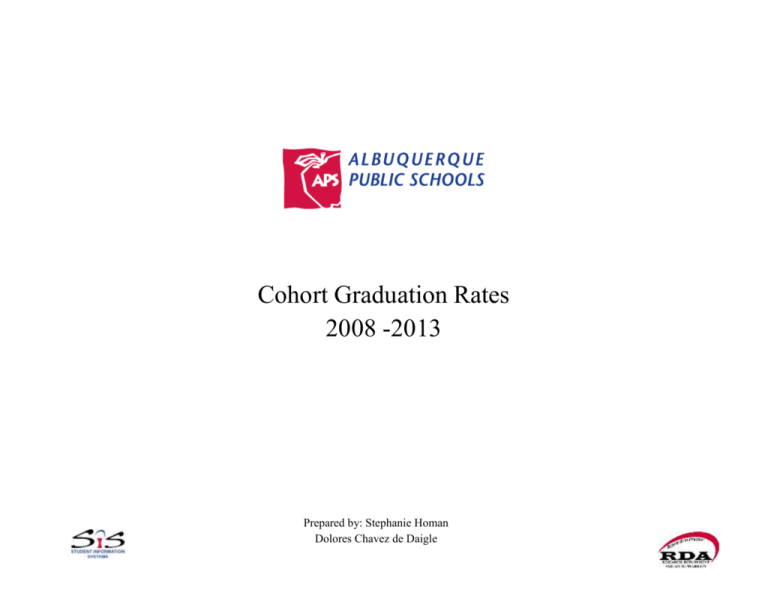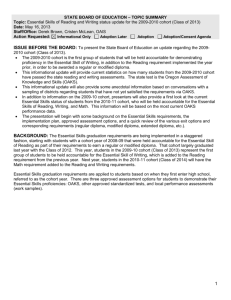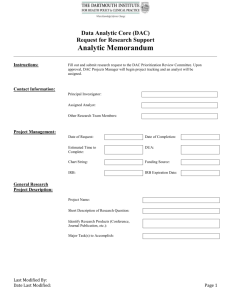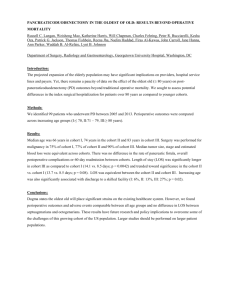Cohort Graduation Rates 2013
advertisement

Cohort Graduation Rates 2008 -2013 Prepared by: Stephanie Homan Dolores Chavez de Daigle New Mexico implemented its first 4-year cohort graduation rate in 2009, transitioning to the National Governors Association (NGA) cohort computation method. The cohort consists of all students who were first-time freshmen four years earlier and who graduated by August 1 of their 4th year plus any students who transfer into the state and district during the four-year period for that cohort. Additionally, cohorts are tracked for one additional year past their expected year of graduation, yielding a 5-year graduation rate. The 4-year rate is utilized for annual school and district accountability. New Mexico's Shared Accountability model was reviewed by the U.S. Department of Education and approved in the spring of 2010. The unique features of Shared Accountability are: All schools with any grade 9, 10, 11, or 12 receive a rate. Student outcomes are distributed proportionally to all high schools that student attended. All students entering New Mexico public high schools become members of an on-time cohort. Students are proportioned into 16 units (one each for the four reporting periods each year across the four years of high school). The number of records a student generates to be reviewed and validated depends on the number of transfers the student makes during his/her high school career. A student enrolled in a NM public school for all four years of high school will generate 16 points or units. If the student remains in one district or school all 16 points are attributed to that district or school. If the student were to transfer during his 2 year of high school to a different district; each district would share the accountability with the student counting 8/16th or 0.5 for one district and 8/16th or 0.5 for the second district. When rates are presented for four or five year cohort graduations, the numbers associated with the rates are not students but in fact records that represent units or points associated with a student’s enrollment. PED has published 4-year rates for four cohorts or graduating classes and provided that information by each NCLB reporting category. Five year cohort graduation rates have been provided for the class of 2008, 2009 and 2010 with detailed categories for 2009 and 2010. For the 2011 4-year cohort the PED established new regulations about how students are classified into a cohort group. The PED announced these changes after data for the 2011 cohort had been submitted to the PED for verification through the STARS reporting system. The specific changes are: special education students who continue after their fourth year of high school must be identified as a graduate even if they intend to continue their education; this was not the practice for the 2001 class and therefore these students were counted as non-graduates; pregnant students had previously been afford an additional year to graduate "on time" and this was discontinued in the 2011 cohort; charter schools approved by the local board are now included in the district rates. Students who did not complete all four years of high school in New Mexico were previously counted for only the portion of their attendance in a New Mexico public school; now these students count as if they were enrolled for all four years (counting a full 16/16th). Students who entered a New Mexico public school as repeating 9th grade were counted in their previous cohort (their first year in 9th grade). For the 2011 these students who were repeating 9th grade but enrolling in a New Mexico school for the first time are counted as first time 9th graders for this cohort. Students who repeat 9th grade are at high risk for not completing high school even in 5 years. In 2012, the PED made it clear that designation of the cohort year for each student included in the cohort is established when the student is found to be in two consecutive reporting periods in the state. Therefore, unlike previous years, where the cohort year was established based on the first time enrollment in any district, the cohort year is established when students are enrolled in two consecutive reporting periods in the state, regardless of when students enter a particular district. For 2013 only the four-year cohort was available at the time of publication of this document. 100 APS Four Year Cohort Trend 95 4 Yr Cohort - All Students 90 4 Yr APS Non Charters Only 85 80 75 73.3 70.1 70 66.9 65.1 65 63.2 68.7 64.7 64.7 60 65 63.4 55 50 2008 Actual 2009 Actual 2010 Actual 2011 Actual 2012 Actual 2013 Actual APS Four and Five Year Cohort Graduation Rates PED Calculated Rates with Shared Accountability Student Groups 4 Year Rate 2010 2011 64.7 63.4 70.2 68.6 59.4 58.3 74.4 75.2 58.7 55.5 60.8 59.5 84.8 77.7 44.4 45.7 2012 65 71.6 58.9 74.6 62.7 61.6 84.7 49.4 2013 68.7 74.2 63.4 76.9 65.6 66.4 87.1 50.3 All Students Female Male Caucasian African American Hispanic Asian American Indian 2008 63.2 67.7 58.7 73.6 62.1 56 78.6 49.4 2009 65.1 69 61.4 76 61.4 58.2 77.2 52.5 Economically Disadvantaged 60.2 46 51.1 51.6 56.5 61.2 Students with Disabilities 57.8 70.3 63.3 44.9 49.2 63.1 English Language Learners 69.9 61.6 58 50.6 57.3 61.8 The PED has provided a 4-Year Cohort Rate for three years, the 2008, 2009, and 2010 for each category of student. In 2011 the PED changed calculations for reporting rates and included charters in the district rate. The 5year rates are provided by category for 2009 and 2010. The four-year rates by individual category of student are shown in the next graph. When interpreting these rates it is important to remember that the rates are based on the numbers of records representing fractions of student enrollment, not students. APS has a higher transfer rate in and out of schools than other districts in the state. Therefore, more students touch our schools and district, giving us more records (fractional parts of student) to consider in calculating the rates and greater likelihood that the new calculation strategies will have a negative impact. Student Groups All Students Female Male Caucasian African American Hispanic Asian American Indian Economically Disadvantaged Students with Disabilities English Language Learners 4 Yr 2009 5 Yr 4 Yr 2010 5 Yr 4 Yr 2011 5 Yr 65.1 69.0 61.4 76.0 61.4 58.0 77.2 52.5 46.0 70.3 61.6 69.8 72.7 66.9 79.1 69.8 63.5 82.9 61.4 54.1 71.4 66.5 64.7 70.2 59.4 74.4 58.7 60.8 84.8 44.4 51.1 63.3 58.0 67.0 72.1 62.1 76.0 60.9 63.7 85.4 48.9 55.8 65.7 61.8 63.4 68.6 58.3 75.2 55.5 59.5 77.7 45.7 51.6 44.9 50.6 67.3 71.9 62.8 77.3 61.1 64.0 81.2 51.6 57.6 53.5 57.3 2012 5-year cohort rates are not available from the PED at the time of publication of this document APS has a greater diversity of student population than other districts in the state. Research supports that the greater the diversity of an urban district the greater the challenges facing students and districts in meeting student needs. When interpreting these rates it is important to remember that the rates are based on the numbers of records representing fractions of student enrollment, not individual students. APS has a higher transfer rate in and out of schools than other districts in the state So more students touch our schools and district, giving us more records (fractional parts of student) to consider in calculating the rates and greater likelihood that the new calculation strategies will have a negative impact. Four Year Cohort Graduation Rates by NCLB Categories PED Calculated Rates with Shared Accountability 100 95 90 84.8 85 80 75 76 73.6 78.6 76.9 74.475.274.6 70 65 62.1 61.4 60 77.7 66.4 65.6 62.7 58.7 55.5 77.2 87.1 84.7 61.6 60.8 59.5 58.2 2008 56 52.5 55 49.4 50 45 49.450.3 45.7 44.4 2009 2010 2011 2012 40 2013 35 30 25 20 15 10 5 0 Caucasian African American Hispanic Asian American Indian Four Year Cohort Graduation Rates by NCLB Categories PED Calculated Rates with Shared Accountability 100 95 90 85 80 75 70.3 69.9 70 65 60 56.5 55 50 63.3 61.2 60.2 63.1 51.1 51.6 46 45 61.8 61.6 58 57.8 49.2 57.3 50.6 44.9 2008 2009 2010 2011 40 2012 35 2013 30 25 20 15 10 5 0 Economically Disadvantaged Students with Disabilities English Language Learners 100 90 80 70 60 50 2010 40 2011 2012 30 20 10 0 2013 Individual School 4-Year Cohort Rates 2010 2011 2012 2013 eCademy 10.6 4.7 25.1 2.9 Albuquerque High 58.1 63.7 67.6 69.5 76.9 75.9 Atrisco Heritage Academy Cibola 76.4 74.3 78.1 78.5 Del Norte 62.2 54.7 59.5 61.9 Early College Academy 74.2 79.2 91.7 90.1 Eldorado 79.8 80.6 79.8 83.5 Freedom 23.1 33.5 37.4 45.2 Highland 46.9 48.9 53.9 64 La Cueva 84.9 85.6 86 87.2 Manzano 67.8 68.1 64 67.6 New Futures 48.2 34.4 27.6 37 Rio Grande 49.6 52.1 55.6 65.4 Sandia 76.7 76.9 77.5 82.5 School on Wheels 15.3 19.3 20.9 26.7 Valley 67.3 69.1 66.2 70.9 Volcano Vista 85.2 79.4 79.9 81.3 West Mesa 53.5 58.2 70 64.7 NexGen 62.2 Some schools such as eCademy do not have graduation classes. However, students who have attended that school will be counted in a cohort graduation that is calculated using portions of students representing the amount of time the student attend that particular site, thus generating a cohort rate for that school. FAQs About how the NM Cohort Graduation Rate is Calculated What is shared accountability? In the past, New Mexico assigned a student’s graduation outcome to the school where they were last enrolled. Mobile students who attended several schools would impact only their most recent school. In order to hold all schools accountable for their effect on graduating students, the shared accountability method was developed to give feedback to all high schools, including those with only 9th or 10th grades. The method apportions a student’s outcome among all schools they attended, and is adjusted by the amount of time spent at each school. Does this mean that mobile students count more than stable students in the rates? No, every student contributes a total count of 1 to the numerator and denominator of the rate for schools, districts, and state. For example, a student who attended 2 schools for equal amounts of time would contribute .50 (or 50%) of their outcome to each school. A student who transfers from another state and enrolls as an 11th grader would count as 1 as well; shared proportionately at each school in which the student enrolled. Who else uses this method? New Mexico is one of the first to use shared accountability. Students are now tracked with multiple yearly snapshots by submissions through STARS from each district in the state. Who is a member of the 2011 cohort? The 4-year cohort (or Class of) 2011 consists of all first-time 9th graders in 2007-08. They are joined by incoming 10th graders in 2008-09, 11th graders in 2009-10, 12th graders in 2010-11. To become a member the student must have been enrolled for at least two reporting periods during the four-year period. How are early graduates counted? All graduates are counted by their cohort year. So a student who entered 9th grade in 2007-08 but who graduated early, in 2010, would STILL be counted as a 2011 graduate. Is the dropout rate the reverse of the graduation rate? No. Every student who does not graduate on-time (within the four years) is not a dropout. Many of those students are still enrolled in our public schools using an extra year to complete required credits. A few of those students have taken and passed the GED and are enrolled in post-secondary programs in our community and some have dropped out. Even among the dropouts our past research has shown that some of those students have transferred out of state to continue their education and failed to notify the district.








